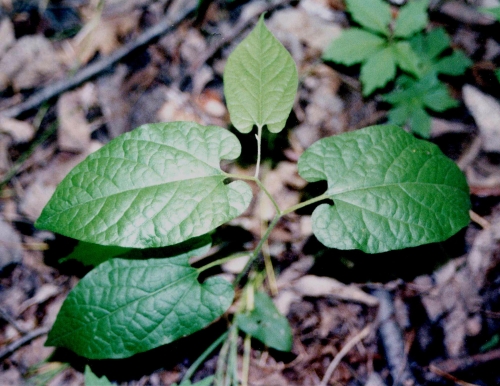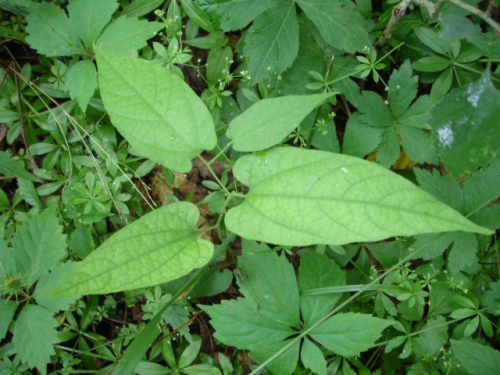Plants and Animals
Endodeca serpentaria Virginia snakeroot
Key Characteristics
Low arching forb (50 cm) of forests; leaves narrowly heart-shaped; flowers dark purple, tubular, borne near ground on leafless stalks.
Status and Rank
US Status: No Status/Not Listed
State Status: T - Threatened (legally protected)
Global Rank: G5 - Secure
State Rank: S2 - Imperiled
Occurrences
| County | Number of Occurrences | Year Last Observed |
|---|---|---|
| Berrien | 3 | 1980 |
| Branch | 2 | 2022 |
| Cass | 4 | 2005 |
| Ionia | 1 | 2022 |
| Kent | 2 | 1985 |
| Lenawee | 4 | 2013 |
| St. Joseph | 2 | 1981 |
| Van Buren | 1 | 1906 |
| Washtenaw | 4 | 2009 |
| Wayne | 2 | 2003 |
Information is summarized from MNFI's database of rare species and community occurrences. Data may not reflect true distribution since much of the state has not been thoroughly surveyed.
Habitat
This plant occurs in a variety of habitats, usually in dry-mesic forests above streams or wetlands, but can also be found at the margins of floodplain forests at the bases of terrace slopes and in rich mesic woods.
Natural Community Types
For each species, lists of natural communities were derived from review of the nearly 6,500 element occurrences in the MNFI database, in addition to herbarium label data for some taxa. In most cases, at least one specimen record exists for each listed natural community. For certain taxa, especially poorly collected or extirpated species of prairie and savanna habitats, natural community lists were derived from inferences from collection sites and habitat preferences in immediately adjacent states (particularly Indiana and Illinois). Natural communities are not listed for those species documented only from altered or ruderal habitats in Michigan, especially for taxa that occur in a variety of habitats outside of the state.
Natural communities are not listed in order of frequency of occurrence, but are rather derived from the full set of natural communities, organized by Ecological Group. In many cases, the general habitat descriptions should provide greater clarity and direction to the surveyor. In future versions of the Rare Species Explorer, we hope to incorporate natural community fidelity ranks for each taxon.
Associated Plants
Red oak, pignut and shagbark hickory, sassafras, Virginia creeper, hepatica, jumpseed, woodland goldenrod, sweet cicely, tulip tree, redbud, wild geranium, hepatica, prickly-ash, poison ivy, hairy yellow violet, big leaf aster, mayapple, silver maple, Eastern cottonwood, willow, red ash, red mulberry, spicebush, wild ginger, green dragon, and nodding wild onion.
Management Recommendations
Management in this habitat type that may impact this species is poorly known. The species may be vulnerable to excessive logging, and is likely adversely affected by invasive species establishment.
Survey Methods
Random meander search covers areas that appear likely to have rare taxa, based on habitat and the judgment of the investigator.
-
Meander search
-
Survey Period: From first week of July to fourth week of August
-
References
Survey References
- Elzinga, C.L., D.W. Salzer, and J.W. Willoughby. 1998. Measuring and Monitoring Plant Populations. The Nature Conservancy and Bureau of Land Management, Denver. BLM Technical Reference 1730-1. 477pp.
- Goff, G.F., G.A. Dawson, and J.J. Rochow. 1982. Site examination for Threatened and Endangered plant species. Environmental Management 6(4): 307-316
- Nelson, J.R. 1984. Rare Plant Field Survey Guidelines. In: J.P. Smith and R. York. Inventory of rare and endangered vascular plants of California. 3rd Ed. California Native Plant Society, Berkeley. 174pp.
- Nelson, J.R. 1986. Rare Plant Surveys: Techniques For Impact Assessment. Natural Areas Journal 5(3):18-30.
- Nelson, J.R. 1987. Rare Plant Surveys: Techniques for Impact Assessment. In: Conservation and management of rare and endangered plants. Ed. T.S. Elias. California Native Plant Society, Sacramento. 8pp.
Technical References
- Flora of North America Editorial Committee. 1997. Flora of North America, North of Mexico. Volume 3: Magnoliophyta: Magnoliidae and Hamamelidae. Oxford University Press, New York. 590pp.
- Gleason, H. A., and A. Cronquist. 1991. Manual of Vascular Plants of Northeastern United States and Adjacent Canada. Second edition. The New York Botanical Garden, Bronx. 910pp.
- Gray, A. 1950. Gray's Manual of Botany; eighth ed. Van Nostrand Reinghold, New York. 1632pp.
- Holmgren, N.H. 1998. Illustrated Companion to Gleason and Cronquist's Manual. Illustrations of the vascular plants of Northeastern United States and adjacent Canada. New York Botanical Garden, Bronx. 937pp.
- Voss, E. G. 1985. Michigan Flora. Part II. Dicots (Saururaceae-Cornaceae). Bulletin of the Cranbrook Institute of Science and University of Michigan Herbarium. 724pp.



